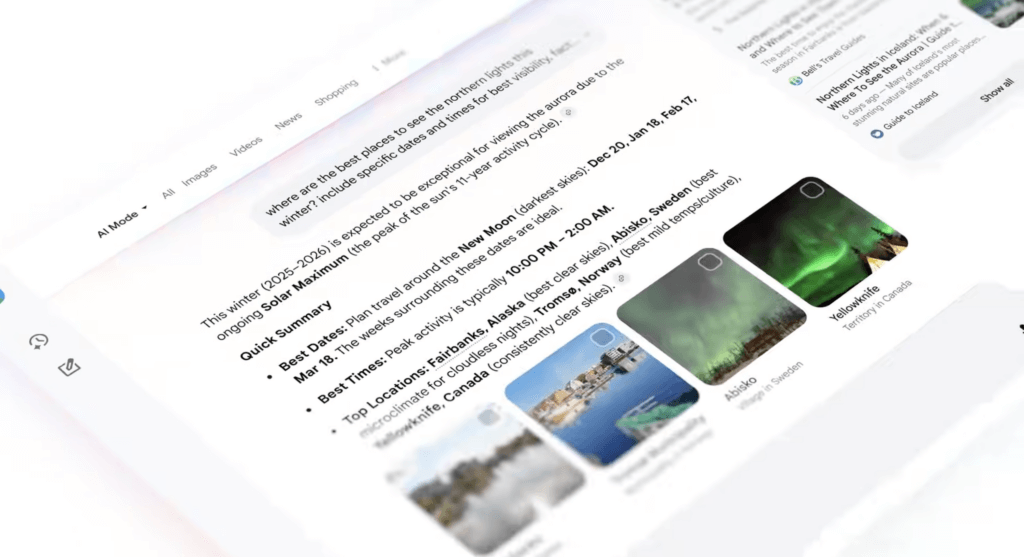OpenAI’s launch of ChatGPT Shopping changed how users search for and buy products. Instead of sending users to a list of search results, ChatGPT delivers direct product recommendations inside the chat interface.
These results feature product images, titles, prices, descriptions, star ratings, review summaries, and buy buttons. Users never have to leave the conversation. There are no ads, no pay-for-placement system, and no preferred retailer partnerships. Products are selected based on relevance to user intent and the quality of structured data.
That means brands that control their product feeds and schema markup are now competing inside a new product discovery layer.
This article outlines how to get listed, how to improve rankings, and how to prepare your eCommerce infrastructure to compete in AI search.
Table of Contents
What ChatGPT Shopping Does Differently
ChatGPT Shopping is built into GPT-4o and 4o-mini. It’s available to all users, including Free and logged-out sessions. When a query shows transactional intent like “best air purifiers under $200” or “best kids chewable multivitamins that don’t contain sugar”, now ChatGPT may return a product carousel instead of links.
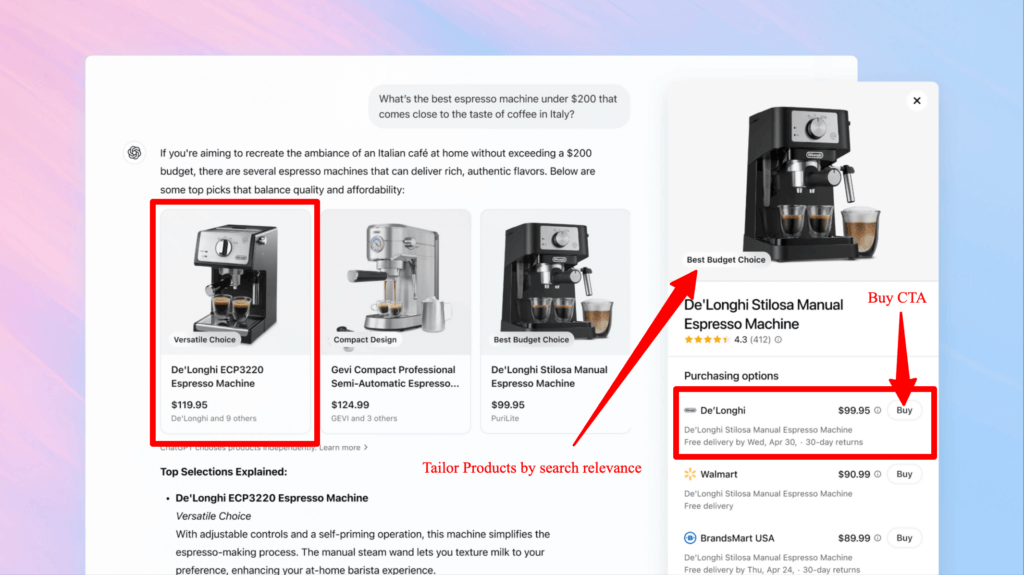
These product carousels show up when the model determines a product is relevant. The decision is made in real time using a mix of structured product data, pricing, review content, user-specific context, and OpenAI’s internal safety filters.
Users can see simplified descriptions written by the model, AI-generated summaries of common review sentiments, and product tags like “Most popular” or “Budget-friendly.” These are not claims made by retailers. They are generated by ChatGPT based on metadata and third-party review content.
Clicking on a product sends users to the merchant’s website. OpenAI does not earn commissions and does not accept paid promotion.
This format favors accurate data, complete schema, and clarity. It filters out stores that rely on keyword stuffing or generic descriptions. Brands with accurate feeds and product copy aligned to buyer intent are best positioned to show up.
5 Steps to Improve Your Store’s ChatGPT Shopping Visibility
To stand out in ChatGPT Shopping results, your product data needs more than visibility—it needs structure, clarity, and alignment with how real users search. These five steps will help your store appear more often, rank higher, and convert better in AI-powered product recommendations. Each one focuses on performance factors already influencing what shows up in ChatGPT’s product carousels: clean metadata, real-time accuracy, conversational relevance, and trust signals. Use this checklist to align your store with what matters now.
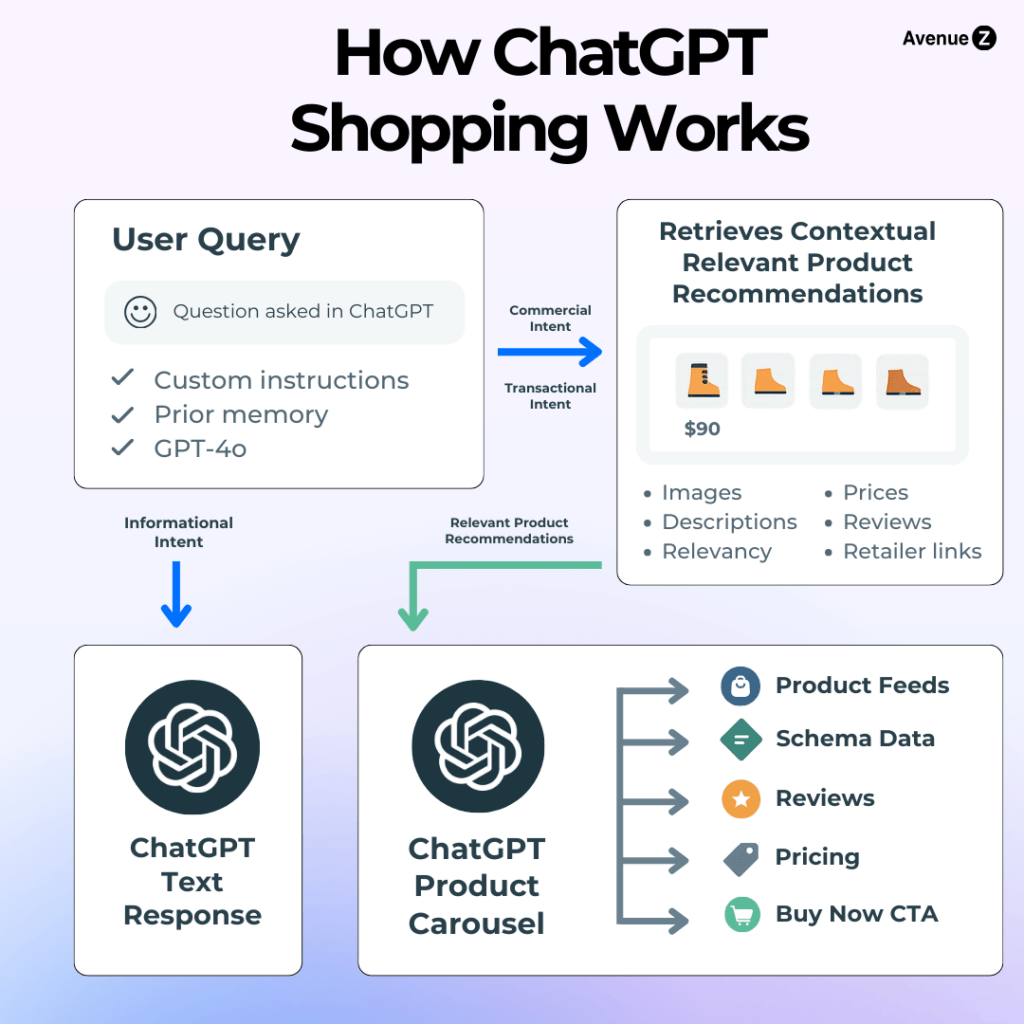
Step 1: Enable OpenAI’s Crawler
Your site must allow OpenAI’s bot to access your product content. Update your robots.txt to ensure the following is in place:
User-agent: OAI-SearchBot
Disallow:If the crawler is blocked, your content will not be discovered or indexed for inclusion in results. Also, it’s recommended to implement a LLMS.txt file.
Step 2: Prepare and Submit Your Product Feed
OpenAI is building a direct product feed submission pipeline. Submissions are not fully live yet, but brands can register now using the Product Discovery Interest Form. This ensures you’ll be contacted as merchant integrations open up.
ChatGPT Shopping ranks products using structured metadata. Data is pulled from your product feed, on-site schema markup, and third-party content sources. The model considers price, availability, user reviews, star ratings, materials, sizing, and any other structured attributes that relate to the query.
The system rewrites product titles and descriptions for clarity. If your metadata is vague, outdated, or missing key context, your products may never appear. Daily feed updates are strongly recommended. Any mismatch between feed content and product pages can reduce visibility.
Schema Attribute Checklist
Use this to audit your schema markup or feed fields. These match the attributes ChatGPT is known to evaluate.
| Attribute | Description |
|---|---|
| id | Unique product ID (SKU or internal code) |
| title | Clear product name that includes core terms |
| description | Short paragraph focused on product benefits |
| link | Direct URL to the product detail page |
| image_link | Primary product image URL |
| additional_image_link | Extra views or angles, if available |
| price | Current selling price |
| sale_price | Sale or discounted price, if applicable |
| availability | Stock status: “in stock”, “out of stock”, or “preorder” |
| brand | Brand name |
| gtin | Global Trade Item Number (UPC, EAN, ISBN) |
| mpn | Manufacturer Part Number |
| condition | New, refurbished, or used |
| item_group_id | Group ID for product variants (colors, sizes) |
| color | Primary color of the product |
| material | Main material (cotton, leather, aluminum, etc.) |
| pattern | Any visible pattern (solid, striped, floral) |
| size | Size label (M, L, 10.5, etc.) |
| size_type | Regular, plus, petite, etc. |
| size_system | US, EU, UK sizing standard |
| gender | Intended gender: unisex, women, men, kids |
| multipack | Number of units in a package |
| bundle | Indicates if product is a bundle: “yes” or “no” |
| shipping | Shipping rates and options |
| tax | Tax information (if included in price) |
| canonical_link | Preferred product URL for indexing |
| review_count | Number of total reviews |
| average_rating | Aggregated star rating |
Step 3: Optimize for Product Relevance
Getting listed is only the beginning. Ranking near the top depends on how well your product aligns with the way people ask questions. Unlike search engines that prioritize link authority, ChatGPT looks for context match.
Build pages that answer user queries
Rewriting your PDP copy for clarity and search intent is no longer optional. Use natural language and short paragraphs. Add FAQ sections. Format your answers to questions shoppers already ask.
Highlight what matters to buyers
If reviews mention “lightweight,” “easy to assemble,” or “fits wide feet,” your description should reflect those points. The model uses review summaries to determine what users value, then looks for products that reflect those traits.
Use structured and visible trust signals
Return policies, warranty details, and shipping transparency influence product selection. Include them directly on your PDPs and in structured data.
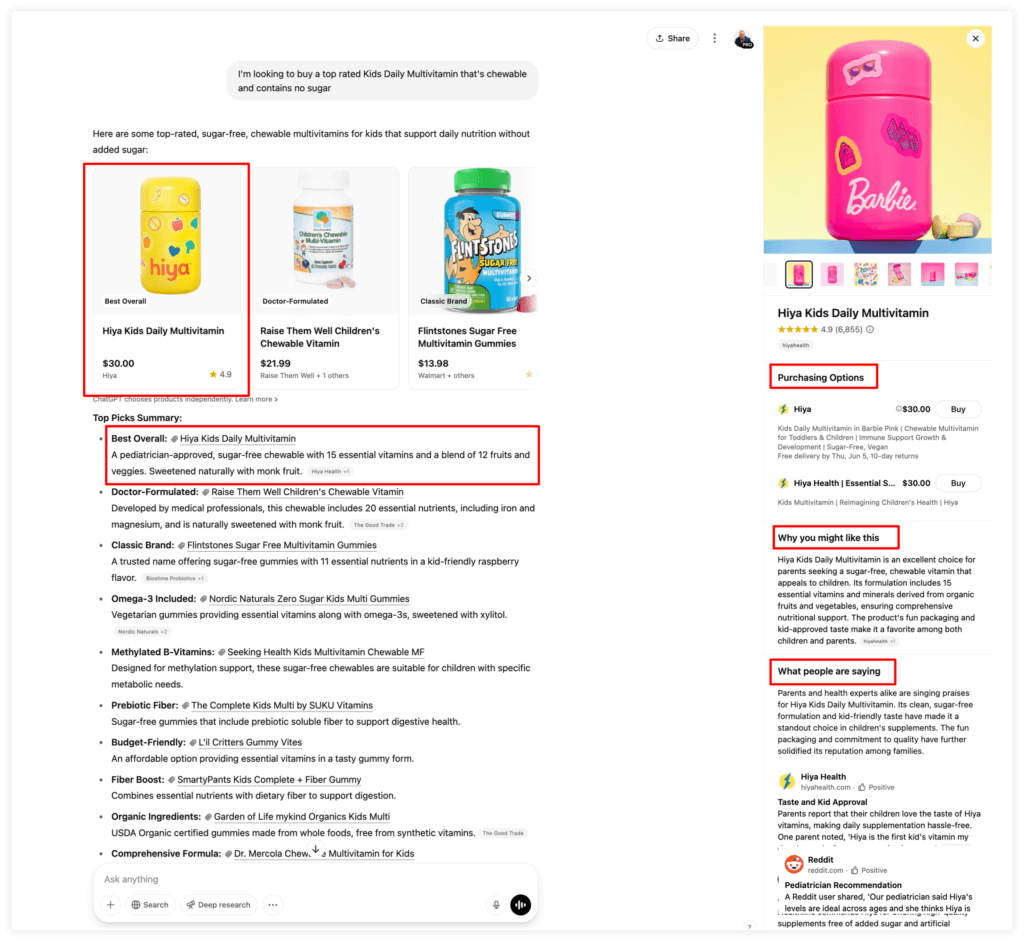
Sentiment Weighting Factors
Sentiment appears to be an important ranking factor as indicated in the “What people are saying” section. This pulls in reviews from various sources such as brand websites, retailers, reddit, social media, review websites, and traditional media outlets. So be sure to maximize your positive review visibility whenever possible across your digital footprint.
ChatGPT Citing Itself
While doing some ChatGPT AI Optimization for some of our clients, we’ve found there are many occasions where ChatGPT is citing itself. Meaning, you can see what it’s searching about specific brands / products to get a better understanding of how it’s doing research.
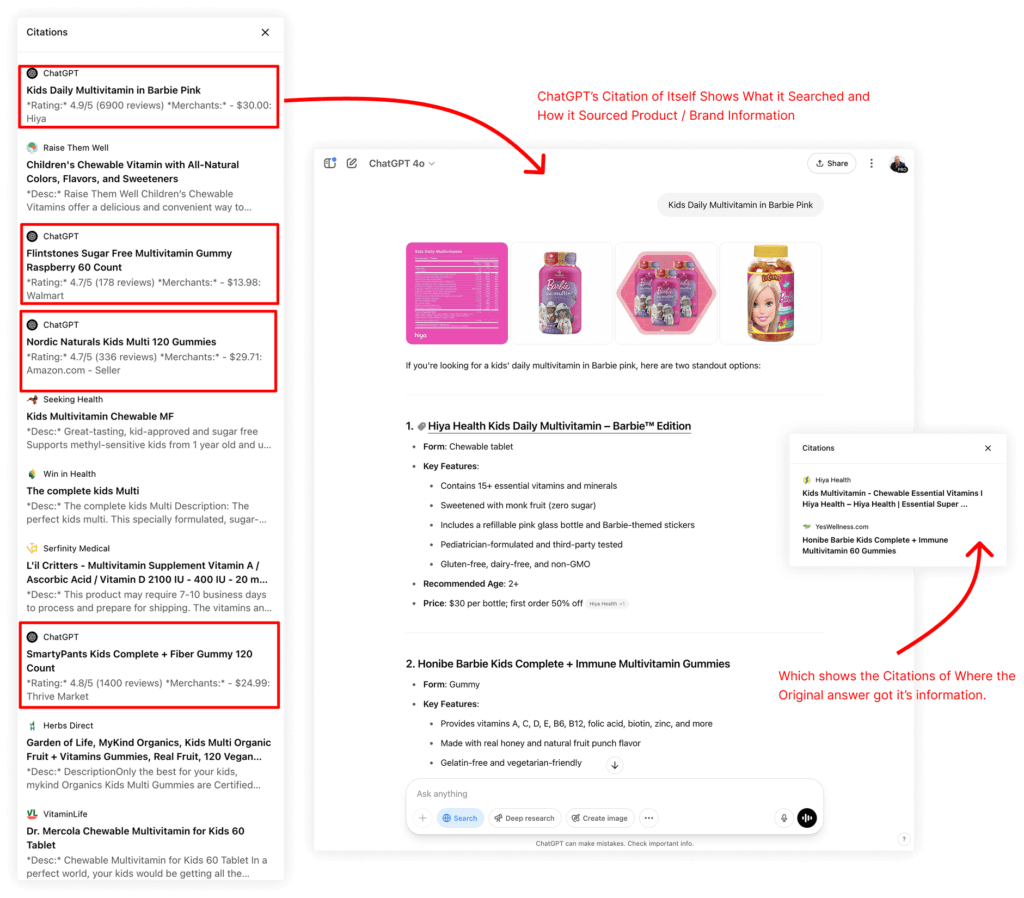
Step 4: Monitor ChatGPT Traffic and Mentions
This is a new surface, and most analytics tools don’t track it out of the box. Here’s how to start building visibility into ChatGPT as a channel:
- UTM Tracking: All outbound links from ChatGPT include
utm_source=chatgpt.com. Build filters in GA4 or Looker Studio. - Unique Offer Codes: Launch promotions tied to ChatGPT-specific codes to measure influence on conversion.
- Post-Purchase Surveys: Ask customers where they first heard about the product. Include ChatGPT in the dropdown.
- Webhook Monitoring: Use N8n or similar to flag traffic spikes or mentions of your product in AI-related sources.
As more users shift product research into ChatGPT, this becomes a performance channel that deserves ongoing optimization and tracking.
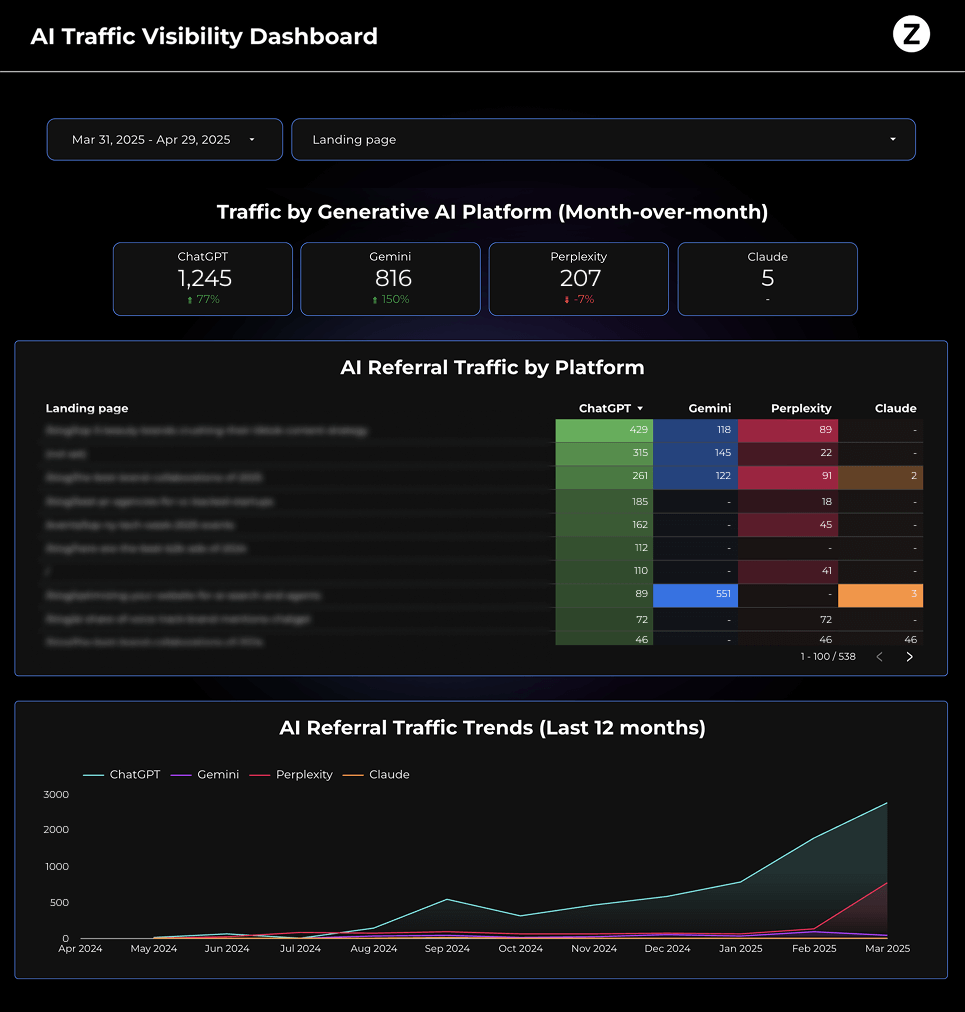
Step 5: Prepare Your Team and Agency Now
The shift to AI-driven shopping is already reshaping product discovery. Teams need to move beyond traditional SEO playbooks and align around data quality, structured content, and intent-driven experiences. That includes your internal marketing, product, and development teams, along with your agency partners.
Most agencies are not built for this change. Avenue Z is. As the leading AI Optimization Agency for Visibility and Commerce, we help brands structure product data, optimize content for AI-first search, and increase visibility in AI-powered shopping results.
This is not a small adjustment. It is a new performance layer. Brands that wait for paid placements to launch will fall behind. Those that align teams and partners now will lead the next era of product discovery.
Want to Learn About AI Visibility?
How to Increase Brand Visibility on ChatGPT
AI-driven search is transforming digital visibility. Learn how to position your brand at the top of ChatGPT and other AI search engines.





